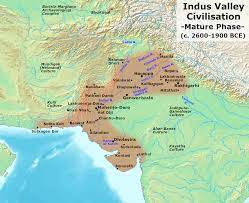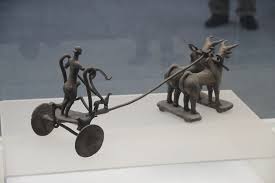INDUS VALLEY CIVILIZATION
In this blogpost we will discuss about HARAPPAN CIVILIZATION OR INDUS VALLEY CIVILIZATION. I am writing this blog post through the help of class 12 NCERT "THEMES IN INDIAN HISTORY PART - 1". There is three books in 12 class --
Part-1 is based on Ancient history
Part-2 is based on Medieval history
Part-3 is based on Modern history
In first book there is four chapter and I will summarize every chapter one by one through my blog post.
 |
| Harappan Seal |
So, This chapter starts from Harappan seal which is the most distinctive artefact of that time. These seals, made of a stone called Selkhadi, usually have animal motifs and signs of a script that has not yet been read.
Terminology, Place, Times
The first term used by archeologists- "Culture" means A group of objects, distinctive in style and they are usually found together, associated with a particular geographical area and time period. In the case of the Harappan culture , these typical antiquities in the context of the Harappan civilization include seals , beads, weights, stone blades, and baked bricks. These objects have been found from areas like Afghanistan, Jammu, Baluchistan (Pakistan) and Gujrat which are located at a long distance from each other.
 |
| Harappa |
This civilization is named after Harappa, the first place where the unique culture was discovered. It has been dated between about 2600 and 1900 BCE. Cultures existed in this region before and after this civilization, which are called early and late Harappan respectively. The Harappan civilization is sometimes called the Mature Harappan culture to differentiate it from these cultures.
Beginnings( Starting )
 |
| Early Harappan Sites |
 |
| Mature Harappan Sites |
Many cultures existed even before the Harappans developed in this region. These cultures were associated with their distinctive pottery style and we also find evidence of agriculture, animal husbandry and some craftsmanship in their context. Settlements were generally small and had almost no sizable structures. There appears to have been a break up between early Harappan and Harappan civilization, with indications of large scale burning at some sites and the abandonment of others.
Ways of Subsistence
The developed Harappan culture flourished in some places where earlier early Harappan cultures existed. These cultures had many elements in common including ways of subsistence. The inhabitants of the Harappan civilization consumed food derived from a variety of plant and animal products, including fish. Archaeologist have been able to reconstruct dietary from finds of charred grains and seeds. These are studied by palaeontologists who specialize in the study of ancient vegetation. Grains found Harappan sites include wheat, barley, lentil, chickpea and sesame. Millets are found from sites in Gujrat. Finds of rich are relatively rare.
Animal bones found at Harappan sites include the bones of cattle, sheep, goats, buffaloes and pigs. Studies done by archaeo-zoologists or zoo-archeologists indicate that these animals were domesticated. Bones of wild species like boar, deer and alligator have also been found. We do not know whether the Harappan themselves hunted these animals or obtained their meat from other hunter-gatherers. Bones of fish and birds have also been found.
Agricultural Technologies
In Harappan civilization cereal grains give indications of agriculture, it is difficult to get clear information about the actual farming methods. Were the seeds sprayed on the ploughed fields?
Artefacts made on seal and terracotta sculpture indicate that there was information about Taurus and on this basis archaeologists believe that oxen were used to plow the field. Also, specimens of clay plows have been found from many sites in Cholistan and from Banwali (Haryana). In addition, archaeologists have found evidence of plowing fields at a place called Kalibangan (Rajasthan), which is associated with the early Harappan levels. In this field there were two steps of plow lines intersecting each other at right angles, indicating that two different crops were grown simultaneously.
Archaeologists have also attempted to identify the tools used to harvest crops. Did the Harappan people use stone blades set in wooden handles or did they use metal tools?
 |
| Agriculture |
Most of the Harappan sites are located in semi arid regions where irrigation would probably be required for agriculture. Some remains of canals have been found from a Harappan sites called Shortughai in Afghanistan, but not in Punjab and Sindh. It is possible that the ancient canals were filled with silt long ago. It may also happen that the water obtained from wells is used for irrigation. Apart from this, the reservoirs found in Dholavira (Gujrat) were probably used for water harvesting for agriculture.
How artefacts are identified
The process of food preparation required grinding machines and utensils for making and cooking. All these were made of stone, metal and clay. Here are some excerpts from one of the earliest reports on excavations at Mohenjodaro, an important Harappan site;
 |
| Vessels |
Saddle querns have been found in large numbers and seem to have been the only means used for grinding grain. These mills were generally made largely of hard, stony, igneous or sandstone and usually show signs of overuse. Since the planes of these mills are usually convex, they must have been deposited in the ground or in the soil to prevent them from moving. Two main types of mills have been found; those on which another smaller stone was pushed or rolled to and fro, and other is what was probably only used to grind herbs and spices to make salan or curry. These other types of stones have been given the name of "Salan stone or Curry stone" by our workers and our cook has borrowed the same stone from the museum for use in the kitchen.






Comments